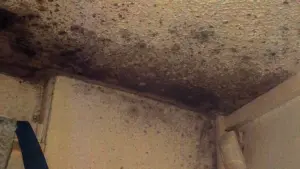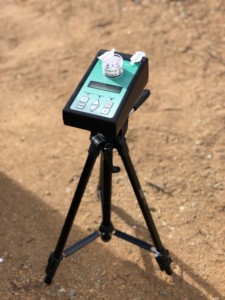Mould: what is it?
Mould is a fungus, like mushrooms and yeast. It is present virtually everywhere, indoors and outdoors.
Mould tends to grow indoors in wet or moist areas lacking adequate ventilation, including:
- walls and wallpaper
- ceilings
- bathroom tiles
- carpets (especially those with jute backing)
- insulation material
- wood
In short, anywhere that moisture accumulates in a building, it’s likely that mould will grow. There are many different types of mould, and all have the potential to cause health problems.

Types of mould
There are more than 100,000 different species of mould, but only 20 to 30 are commonly found in Australian homes. People often refer to mould by colour (white mould, brown mould, pink mould, green mould or black mould), but the specific mould species can’t be identified by colour alone. That’s why it’s important to have mould samples professionally tested in a laboratory like Airsafe’s if you have any concerns.
Mould health risks
In order to reproduce, mould produces tiny particles called spores. Spores are carried in the air and may cause health problems if inhaled by people who are sensitive or allergic to them.
Different types of mould come with different levels of health risk:
- Allergenic moulds can temporarily affect people who are prone to allergies or asthma – about 20% to 30% of the population. They’re often found in areas that have been damp for long periods. Symptoms of an allergic reaction can include a running or blocked nose, irritation of the eyes or skin, wheezing, or an asthma attack.
- Pathogenic moulds can cause infections and diseases, especially in people with vulnerable immune systems, such as infants, elderly people, cancer and transplant patients, or people with chronic diseases.
- Toxic moulds carry the highest level of risk, producing poisonous chemicals called mycotoxins that can lead to serious illness. In Australia, the most notorious toxic mould is Strachybotrys chartarum, also known as toxic black mould.

Why choose Airsafe for mould testing?
Because mould is such a complex area with different types and levels of risk, it’s important to get professional help if you have a mould concern. This means engaging an occupational hygienist with proper training and expertise in mould, backed up by an experienced, accredited laboratory.
Airsafe can undertake a mould inspection or clearance assessment following all legislative requirements.
At Airsafe, we’re proud of our methodical, systematic and diligent procedures for carrying out mould inspections and clearances. To undertake an inspection or clearance, an Airsafe staff member must:
- be completely familiar with the relevant documents
- undertake thorough mould assessment training in Airsafe’s procedures
- be signed off by a supervisor
- undergo routine reviews of mould testing skills and technique
If your occupational hygienist isn’t backed by rigorous procedures like Airsafe’s, there’s a risk that the premises won’t be thoroughly inspected, which can mean areas of mould are missed.
Contact us today for a fast quote on mould testing and assessments.
-
For a mould assessment, an Airsafe occupational hygienist will perform a thorough inspection to determine the source of your mould issue. This is our mould inspection procedure:
- We determine the location of items that are contaminated with mould, or likely to be contaminated.
- We conduct viable mould surface sampling within the identified areas of concern, including a blank sample.
- We conduct airborne mould sampling within the identified areas of concern, including a control sample collected from the exterior of the premises.
- We conduct moisture sampling of building materials and items the occupational hygienist presumes to be wet.
- We undertake laboratory analysis of selected samples by a NATA accredited laboratory.
- We prepare a Mould Inspection Report.

-
The Procedure to conduct a mould clearance assessment may include the following:
- We inspect the premises to see that recommendations from the mould inspection report have been carried out.
- We visually inspect all the previously identified areas of concern and record any interior odours, mould staining or water staining.
- We conduct viable mould surface re-sampling within the areas identified in the inspection assessment, including a blank sample which has not touched any surface.
- We conduct airborne mould re-sampling within the areas identified in the inspection assessment, including a control sample collected from the exterior of the premises.
- We conduct moisture sampling behind or surrounding previously identified wet building materials and items.
- We undertake laboratory analysis of selected samples by a NATA accredited laboratory.
- We prepare a Clearance Certificate.
In addition to microbial monitoring, we may undertake visual inspections and building moisture content readings to determine the susceptibility of construction material to mould colonisation.

-
Mould is a common source of dispute between landlords and tenants. It’s the responsibility of landlords to ensure their property meets health and safety laws, but mould can also be present due to the actions of tenants. According to NSW Fair Trading:
- if mould developed from a build-up of moisture because the landlord failed to repair a defective window in a reasonable time, or the property didn’t have adequate ventilation – then the landlord is responsible and must fix the problem
- if the mould developed during the tenancy because the tenants allowed a build-up of moisture by never opening any windows or not using ventilation fans in the bathroom – then the tenant may be responsible.
Airsafe’s services are available to either landlords or tenants who wish to investigate, test or monitor the extent of mould in a rental property.

Contact us for mould testing and inspections today
Airsafe is here to keep you safe with our comprehensive mould testing, inspections and assessment reports. When you need help with mould in Sydney, it’s best to get in touch with the experts on 1300 888 338.





